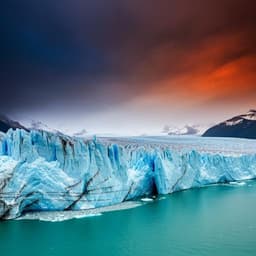
Earth Sciences
Earlier ice loss accelerates lake warming in the Northern Hemisphere
X. Li, S. Peng, et al.
Discover how long-term changes in lake ice phenology are reshaping surface water temperature across the Northern Hemisphere. This groundbreaking research by Xinyu Li, Shushi Peng, Yi Xi, R. Iestyn Woolway, and Gang Liu reveals that an 8-day advancement in ice break-up could significantly impact lake ecosystems, resulting in a remarkable 1.4-fold increase in warming during ice-off months.
~3 min • Beginner • English
Introduction
More than 90% of the world’s lakes lie north of 30°N, and many freeze each winter. Lake ice modifies air–water exchanges by increasing surface albedo and blocking direct atmospheric forcing; thus ice phenology (timing of freeze-up and break-up) controls seasonal surface energy budgets and thermal regimes. With climate warming, many lakes are freezing later and breaking up earlier, extending the open-water season. These shifts can alter seasonal and interannual variability of lake surface water temperature and affect stratification, biogeochemistry, and ecosystem processes. The key research question is whether and by how much changes in ice phenology drive excess warming during the transitional ice-off and ice-on months across the Northern Hemisphere, relative to the open-water season. The study aims to quantify these effects using satellite observations and global reanalysis-driven lake simulations, and to identify the primary drivers and sensitivities governing spatial variation in excess warming.
Literature Review
Prior studies document widespread trends toward later ice-on and earlier ice-off under warming, lengthening the ice-free season. Changes in ice timing influence LSWT variability, stratification onset, primary production, and ecosystem services. Summer LSWT trends have been linked to air temperature, solar radiation, and wind changes, but the magnitude of change during ice-off and ice-on months remains uncertain. Local and regional studies have suggested earlier ice-off and/or later ice-on can produce excess surface warming during these months, yet this phenomenon has not been tested across large regions. Additionally, earlier ice-off can advance phytoplankton blooms and stratification, alter water quality, and affect winter ice-dependent services. The literature also indicates potential roles of radiation regimes, lake depth, latitude, and elevation in modulating LSWT responses, but their relative contributions to excess warming during transitional months were unclear at hemispheric scales.
Methodology
Data sources: (i) Satellite lake surface water temperature (LSWT) from ARC-Lake (ATSR) for 963 lakes north of 30°N (1995–2012), and CCI Lakes (2007–2019) for validation; (ii) ERA5 reanalysis lake simulations using the FLake 1D model at 0.25° × 0.25° (1979–2020), representing 109,405 lake grid cells (typical lake per grid). ERA5 ancillary variables included downward short-wave and long-wave radiation, 2-m air temperature, lake bottom temperature, and static lake depth.
Ice phenology detection: Using daily LSWT from ERA5 (1979–2020) and ARC-Lake (1995–2012), ice-covered periods were identified when LSWT <1 °C. Ice-on date was defined as the first day after July 1 when ice cover persisted ≥10 consecutive days; ice-off date was the first day with ≥10 consecutive ice-free days. Lakes with ice-cover duration <30 days were excluded. Phenology estimates were validated against AMSR-E/2 microwave-derived ice phenology (2002–2015; R > 0.73) and against ERA5 ice thickness-based phenology (R > 0.95).
Trend calculations: Monthly LSWT trends (1979–2020) were computed for each lake grid. The open-water season was defined as all months outside ice-cover periods. For each lake, the month of ice-off and the month of ice-on were identified annually and used to extract the corresponding LSWT series.
Excess warming metrics: R_IOFF and R_ION were defined as the ratio of the trend in LSWT during the ice-off month (LSWT_IOFF) or ice-on month (LSWT_ION) to the trend during the open-water season (mean trend across open-water months). Spatial patterns and probability density functions of R_IOFF and R_ION were mapped and summarized by continent.
Drivers and attribution: Across-lake variability in excess warming was related to trends in ice phenology, climate variables during relevant months (air temperature, downward SW and LW radiation), geographic variables (latitude, elevation), and lake depth. Correlations and partial correlations were computed to quantify explanatory power (coefficients of determination, R^2). Additional incoming radiation associated with earlier ice-off was approximated using the product of the trend in ice-off date and mean downward SW/LW radiation in the ice-off month (ΔE terms).
Sensitivity analysis: Sensitivities S_IOFF (°C per day earlier ice-off) and S_ION (°C per day later ice-on) were estimated to quantify LSWT response to 1-day changes in ice timing across lakes. Relationships of sensitivities with lake depth (log scale) and incoming radiation (SW + LW during the month) were assessed.
Stratification analysis: Stratification onset dates were estimated from simulated temperature differences between epilimnion and hypolimnion. The timing relative to ice-off was summarized (fraction stratifying in ice-off month; advancement rate) and the occurrence of incomplete overturn (≤3 days between ice-off and stratification) was assessed.
Satellite comparison: ARC-Lake and CCI Lakes LSWT trends were compared to ERA5-based trends for consistency (good agreement reported). Main results emphasized ERA5 due to longer temporal coverage and spatial completeness, with satellite-derived results provided in Supplementary Information.
Statistics and selections: Only lakes/grid cells with at least one year of valid phenology and sufficient temporal coverage were included. Significance of trends was assessed; percentages of variance explained were reported via regression R^2 without implying causality.
Key Findings
- Excess warming during ice-off month: Across three example high-latitude lakes, peak warming trends in the ice-off month were 0.4–1.0 °C per decade, 1.5–3.1× higher than open-water season trends. Grouping lakes by ice-off month showed peak warming in the ice-off or subsequent month; excess magnitude increased with later ice-off timing.
- Ratios: Across the Northern Hemisphere, average R_IOFF increased from 1.2 ± 0.9 (March ice-off) to 1.4 ± 1.3 (July ice-off). Overall, 51% of lakes had R_IOFF > 1, 34% > 1.5, and 13% > 3. Continental means: Asia 2.0 ± 1.6, Europe 1.2 ± 0.7, North America 0.7 ± 1.1. For ice-on months, mean R_ION = 0.6 ± 0.5 (Europe 0.7 ± 0.4; Asia 0.6 ± 0.5; North America 0.5 ± 0.6); only 5% had R_ION > 1.5 and 1% > 3.
- Phenology trends and LSWT links: Ice-off dates advanced by 8.1 ± 6.4 days (1979–2020), correlating with LSWT_IOFF trends (R = 0.61, p < 0.001). Spatial co-occurrence included Siberia (advance >0.4 d yr−1; LSWT_IOFF warming >0.1 °C yr−1) and southern Canada (delayed ice-off <0.05 d yr−1; LSWT_IOFF cooling < −0.01 °C yr−1).
- Attribution: Climate variables during ice-off month (air temperature, SWdown, LWdown) explained little of across-lake variation in R_IOFF (R^2 ≈ 4%, 0%, 5%), and similarly low for R_ION (6%, 0%, 5%). Latitude/elevation each explained <4% of R_IOFF and R_ION variability. By contrast, 79% of lakes with maximum monthly warming in ice-off month had significant earlier ice-off (p < 0.05). After accounting for ice-off trends, lake depth (log) showed a partial correlation with LSWT_IOFF trend of 0.49 (p < 0.001). Overall, ice-off trend explained 37% and lake depth 24% of across-lake variation in LSWT_IOFF trends, much higher than climate variables (<11%). During ice-on month, ice-on date trend correlated with LSWTION trend (R = 0.63), and LWdown (R = 0.42) and air temperature (R = 0.45) were more correlated than depth (R = −0.14).
- Sensitivities: Mean S_IOFF = 0.14 °C day−1; mean S_ION = 0.06 °C day−1, consistent with higher incoming radiation during ice-off (408–564 W m−2) than ice-on (256–366 W m−2). The 8.1-day earlier ice-off contributed 1.1 ± 0.9 °C excess warming (~81 ± 76% of the total LSWT_IOFF warming of 1.8 ± 1.4 °C). Without earlier ice-off, LSWT_IOFF warming would be similar to open-water season warming (1.4 ± 0.7 °C). The 6.7 ± 6.8-day later ice-on contributed 0.4 ± 0.4 °C (~64% of LSWTION warming of 0.8 ± 0.7 °C). Dimming of SWdown during ice-on months vs. brightening in open-water helps explain R_ION < 1 for most lakes.
- Regulation by depth and radiation: S_IOFF decreases by ~60% (≈0.12 °C day−1) for a one-order-of-magnitude increase in depth; increases by ~0.12 °C day−1 per +100 W m−2 of incoming radiation. S_ION decreases by ~33% (≈0.03 °C day−1) with increasing depth and increases by ~0.07 °C day−1 per +100 W m−2.
- Stratification response and legacy: Only 16% of lakes stratified during the ice-off month; 80% showed earlier stratification onset (advancing at ~0.2 d yr−1). Earlier ice-off produced a legacy warming effect lasting ~3 months, with variance explained by earlier ice-off decreasing from 37% (ice-off month) to 3% by the third month. Incomplete overturn occurred at least once in 14% of lakes.
Discussion
The study demonstrates that earlier ice-off and later ice-on systematically enhance LSWT warming during the transitional months across the Northern Hemisphere, with the strongest and most widespread effect in the ice-off month. By isolating the ratio of transitional-month warming to open-water warming and relating it to phenological shifts, the work shows that ice phenology—and not solely summer climate drivers—dominates the timing and magnitude of excess warming at these critical transitions. Lake depth modulates the warming response by setting the volume of water heated prior to stratification, while higher incoming radiation during the ice-off month amplifies sensitivity to earlier ice loss. During ice-on months, despite some excess warming associated with later freeze-up, lower incoming radiation and dimming effects limit the relative warming (R_ION < 1 for most lakes), and radiation and air temperature have stronger associations with LSWT trends than depth.
These findings bridge a knowledge gap by providing a hemispheric-scale assessment that corroborates prior local studies, linking changes in ice phenology to enhanced early-season warming. The legacy of earlier ice-off extends into subsequent months, advancing stratification and potentially reinforcing surface warming and biogeochemical changes. The ecological implications include altered bloom timing, species composition shifts, stronger and longer stratification, reduced deep-water oxygen, and risks to cold-water fishes. The work highlights that ongoing and projected changes in ice phenology can substantially reshape lake thermal regimes beyond what summer trends alone would suggest.
Conclusion
This study quantifies hemispheric-scale excess lake surface warming during ice-off and ice-on months and attributes it primarily to earlier ice break-up and later ice formation. On average, LSWT warming during ice-off months is ~1.4× that of the open-water season, with an ~8-day earlier ice-off contributing ~1.1 °C of excess warming since 1979. Lake depth and incoming radiation modulate sensitivity, with shallower lakes and higher radiation exhibiting stronger responses. During ice-on months, later freeze-up contributes to excess warming, but lower radiation and dimming effects limit relative warming.
Projected future advances in ice-off timing (15–45 days earlier under RCP8.5 by late century) imply an additional 2.0–6.1 °C increase in LSWT during ice-off months, with potential for even greater amplification where ice-free winters occur. Future work should (i) improve representation of bathymetry, water balance, and water clarity dynamics; (ii) resolve intra-lake spatial heterogeneity and nearshore–offshore contrasts; (iii) integrate biological responses to altered thermal regimes; and (iv) assess socioeconomic and ecosystem service impacts of changing ice phenology and transitional-month warming.
Limitations
- Data/model constraints: ERA5 uses the 1D FLake model with simplified bathymetry, fixed depth and surface area (no water balance), and no temporal dynamics in water clarity (light attenuation), introducing uncertainty, particularly in shallow or highly variable lakes.
- Satellite vs. bulk temperature: Satellite LSWT represents skin (~<0.1 mm) temperatures, which can differ from bulk temperatures by tenths of a degree depending on conditions; however, long-term coupling is strong. Using lake-mean satellite temperatures may mask intra-lake heterogeneity.
- Spatial heterogeneity: Analyses average across lake surfaces and do not resolve within-lake spatial differences (e.g., nearshore vs. offshore), which are important in large/deep lakes.
- Phenology detection: Ice phenology inferred from temperature thresholds and persistence criteria may misclassify intermittent conditions; though validated against microwave products and ice thickness, residual errors remain.
- Forcing uncertainties: Radiation and meteorological forcings from reanalysis and satellite retrievals carry uncertainties; attribution uses correlations and R^2 that do not imply causality.
- Model physics: Lack of explicit mixing processes beyond 1D limits representation of complex overturn and lateral processes; stratification timing is inferred from modeled temperature profiles.
Related Publications
Explore these studies to deepen your understanding of the subject.







